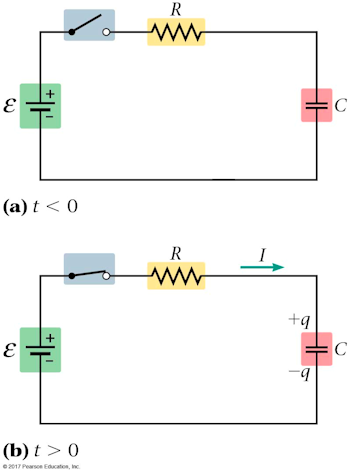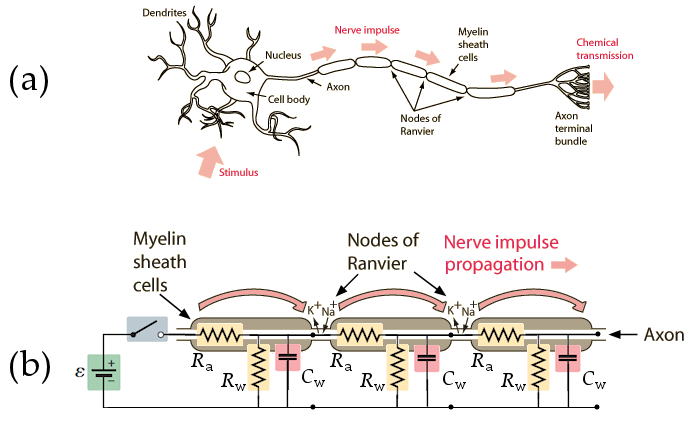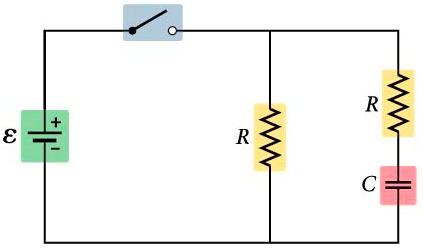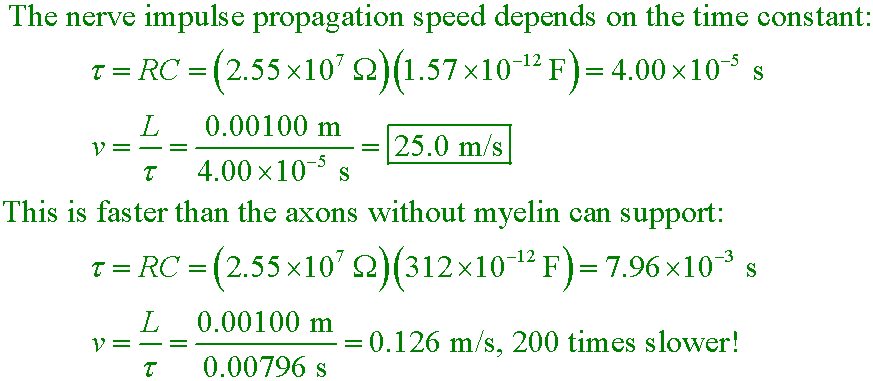Summary
- Ohm's Law
- Electric power
- Kirchhoff's rules

- Written Quiz Ch. 20
End of material on Exam I
- Circuits with capacitors
- Capacitors in series and in parallel
Example #1
Example #2
- Charging and discharging in RC circuits applet
- An uncharged capacitor is like a wire
- A charged capacitor is like an open circuit
- Circuit Applet for flashlamp circuit (problem 21.80)
- Nerve impulse propagation speed (problem 21.81)
Example #3
Example #4
Example #5
- Lecture learning outcomes
A student who masters the topics in this lecture will be able to:
- calculate the equivalent capacitance of capacitors connected in series or connected in parallel
- use characteristics of uncharged and charged capacitors to predict the behavior of simple resistor-capacitor circuits both immediately after a battery is connected and a long time after the battery is connected
- [We will not study the RC time constant or the time-dependent exponential behavior of resistor-capacitor circuits.]
Practice:
Try these additional examples
Example #6
Example #7
Example #8
Prepare:
Read textbook section 22-1 before the next lecture
POP4 20.49
Two capacitors of 25 µF and 5 µF are connected in parallel with 100 V across each.
What is the total energy stored?
A. 150 µJ
B. 0.150 J
C. 150 J
D. 150 kJ
Answer
POP4 20.49
Two capacitors of 25 µF and 5 µF are connected in series.
What ΔV is required to store 0.150 J?
A. 22.8 V
B. 100 V
C. 137 V
D. 268 V
Answer
Walker5e 21.81
The speed that nerve impulses travel is given by v = L/RC, where L = 0.0010 m is the length of an axon, R = 2.55×107 Ω is its resistance, and C is its effective "wall capacitance." The presence of a myelin sheath decreases the wall capacitance from 314×10−12 F (314 pF)to only 1.57×10−12 F (1.57 pF). The myelinated axons therefore support a ____ speed of ____.

A. higher ... 25.0 m/s
B. higher ... 63.7 m/s
C. lower ... 25.0 m/s
D. lower ... 63.7 m/s
Answer
klm Walker5e CnEx 21-19
The switch in the figure below is initially open and the capacitor is uncharged. If ℰ = 6.00 V, R = 10.0 Ω, and C = 72.0 µF, what current flows through the battery immediately after the switch is closed?
 circuit simulator
circuit simulator
A. 0.432 mA
B. 0.600 A
C. 0.900 A
D. 1.20 A
Answer
klm Walker5e CnEx 21-19
The switch in the figure below is initially open and the capacitor is uncharged. If ℰ = 6.00 V, R = 10.0 Ω, and C = 72.0 µF, what current flows through the battery a long time after the switch is closed?

A. 0.432 mA
B. 0.600 A
C. 0.900 A
D. 1.20 A
Answer
klm Walker5e Ex 21-17
If C = 24.0 µF in the circuit below, what is the equivalent capacitance of the entire circuit?

A. 8.00 µF
B. 16.0 µF
C. 36.0 µF
D. 72.0 µF
Answer
Walker5e 21.61
Two capacitors, C1 = C and
C2 = 2C, are connected to a battery. Capacitor _____ stores more energy when they are connected to the battery in series and capacitor _____ stores more energy when they are connected in parallel with the battery.
A. C1 ... C1
B. C2 ... C1
C. C1 ... C2
D. C2 ... C2
Answer
sj6 28.33
 The battery has been connected to the circuit below for a long time. What is the voltage across the capacitor?
The battery has been connected to the circuit below for a long time. What is the voltage across the capacitor?
A. 2.00 V
B. 4.00 V
C. 6.00 V
D. 8.00 V
Answer
B. 0.150 J

D. 268 V


A. higher ... 25.0 m/s


D. 1.20 A
Immediately after the switch is closed the capacitor is uncharged and behaves like a wire. The 6.00-V battery drives 0.600 A of current through each of the 10.0-Ω resistors (or, if you prefer, the two resistors in parallel have an equivalent resistance of 5.00 Ω) resulting in 1.20 A flowing through the battery.

B. 0.600 A
A long time after the switch is closed the capacitor is fully charged and behaves like an open circuit. The 6.00-V battery drives 0.600 A of current through the left-hand 10.0-Ω resistor.

C. 36.0 µF
The two capacitors in series have an equivalent capacitance of ½C, and they are connected in parallel with a third, identical capacitor. Hence we add the two capacitances to get an equivalent capacitance of 1.50C, or 1.50×24.0 µF = 36.0 µF.
C. C1 ... C2
When connected in series the two capacitors have the same charge. By noting that U = ½Q²/C you can see the smaller capacitor C1 stores the most energy. (Confirm for yourself that if the battery voltage is 6.0 V and C = 10.0 µF, C1 stores 80 µJ and C2 stores 40 µJ.)
When connected in parallel the two capacitors have the same voltage. By noting that U = ½CV² you can see the larger capacitor C2 stores the most energy. (Confirm for yourself that if the battery voltage is 6.0 V and C = 10.0 µF, C1 stores 180 µJ and C2 stores 360 µJ.)

C. 6.00 V

The left side of the capacitor is at the higher potential.


 circuit simulator
circuit simulator

 The battery has been connected to the circuit below for a long time. What is the voltage across the capacitor?
The battery has been connected to the circuit below for a long time. What is the voltage across the capacitor?


